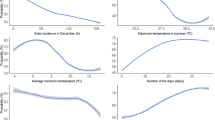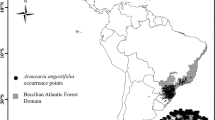Abstract
The objective of this study was to assess the impact of climate change on keystone subalpine conifers, Tsuga diversifolia and Abies veitchii, incorporating the uncertainties of general circulation models (GCMs) for spatial conservation planning in Japan. Potential habitats for T. diversifolia and A. veitchii under current and 20 GCMs in 2080–2100 were predicted using generalized additive models. We counted the number of GCMs under which current potential habitat was predicted to lose by a spatial unit and used them as indices of vulnerability and prediction uncertainty. Gaps between protected areas and potential habitats under the future climates were identified. Reasonably accurate models revealed that T. diversifolia and A. veitchii require cool and wet summers with low winter precipitation. Only less than 1 % of current potential habitats for the species were predicted to be sustainable with low GCMs-related uncertainties. Most of these certainly sustainable habitats were designated as protected areas. Of current potential habitats for T. diversifolia and A. veitchii, 88 and 97 % were predicted to be non-habitats under future climates with low GCMs-related uncertainties. These certainly vulnerable habitats included the southern and low elevated northern range limits of the species, of which 70 % were designated as protected areas. These results suggest that subalpine conifers are vulnerable to the climate change irrespective of GCMs variation. Strengthening of monitoring may be necessary, especially at unprotected and certainly vulnerable habitats in lower subalpine areas where influences of the climate change will appear first. Active management including assisted regeneration may be necessary for preserving the vulnerable and genetically endemic populations.






Similar content being viewed by others
References
Aizawa M (2005) Reconfirmation of localities recorded up to today by examination of voucher specimens and by investigation in the habitats-Case study of the five subalpine conifer species in Honshu, Japan. J Phytogeogr Taxon 53:13–42 (In Japanese with English summary)
Beaumont LJ, Hughes L, Pitman AJ (2008) Why is the choice of future climate scenarios for species distribution modelling important? Ecol Lett 11:1135–1146. doi:10.1111/j.1461-0248.2008.01231.x
Begon M, Harper JL, Townsend CR (1996) Ecology: individuals, populations and communities, 3rd edn. Blackwell Science, Oxford 1068 p
Braun-Blanquet J (1964) Pflanzensoziologie, 3 Aufl. Springer, Wien
Buisson L, Thuiller W, Casajus N, Lek S, Grenouillet G (2010) Uncertainty in ensemble forecasting of species distribution. Glob Change Biol 16:1145–1157. doi:10.1111/j.1365-2486.2009.02000.x
Burnham KP, Anderson DR (1998) Model selection and multimodel inference: a practical information-theoretic approach, 2nd edn. Springer, New York
Caro T (2010) Conservation by proxy: indicator, umbrella, keystone, flagship, and other surrogate species. Island Press, Washington, DC
Chape S, Harrison J, Spalding M, Lysenko I (2005) Measuring the extent and effectiveness of protected areas as an indicator for meeting global biodiversity targets. Philos Trans R Soc Lond Ser B 360:443–455. doi:10.1098/rstb.2004.1592
Fujii S, Moriguchi Y, Uchiyama K, Suzuki S, Tsumura Y (2012) Genetic structure and population history of three Japanese Abies species revealed by chloroplast DNA and EST-SSR markers. 5th East Asian Fed Ecol Soc, Jpn
Hamann A, Wang T (2006) Potential effects of climate change on ecosystem and tree species distribution in British Columbia. Ecology 87:2773–2786. http://www.jstor.org/stable/20069297
Hannah L, Midgley G, Andelman S, Araújo M, Hughes G, Martinez-Meyer E, Pearson R, Williams P (2007) Protected area needs in a changing climate. Front Ecol Environ 5:131–138. http://www.jstor.org/stable/20440608
Hannah L, Midgley GF, Millar D (2002) Climate change-integrated conservation strategies. Glob Ecol Biogeogr 11:485–495. doi:10.1046/j.1466-822X.2002.00306.x
Hayashi Y (1951) The natural distribution of important trees, indigenous to Japan. Conifers report I. Bull Gov For Exp Sta 47:1–240 (In Japanese with English summary)
IPCC (2001). In: McCarthy JJ, Canziani OF, Leary NA, Dokken DJ, White KS (eds) Climate change 2001: impacts, adaptation and vulnerability. Contribution of working group II to the third assessment report of the intergovernmental panel on climate change, Cambridge University Press, Cambridge
IPCC (2007). In: Solomon S, Qin D, Manning M, Chen Z, Marquis M, Averyt KB, Tignor M, Miller HL (eds) Climate change 2007: the physical science basis. Contribution of working group I to the fourth assessment report of the intergovernmental panel on climate chage, Cambridge University Press, Cambridge
Iverson LR, Prasad AM (1998) Predicting abundance of 80 tree species following climate change in the eastern United States. Ecol Monogr 68:465–485. doi:10.1890/0012-9615(1998)068
Japan Meteorological Agency (1996) Climatic normals for Japan. Japan Meteorological Business Support Center, Tokyo. (In Japanese)
Kanzaki M (1984) Regeneration in subalpine coniferous forests I. Mosaic structure and regeneration process in a Tsuga diversifolia forest. Bot Mag Tokyo 97:297–311. doi:10.1007/BF02488663
Kira T (1948) On the altitudinal arrangement of climatic zones in Japan. Kanti-Nougaku 2:143–173 (In Japanese)
Lemieux CJ, Scott DJ (2005) Climate change, biodiversity conservation and protected area planning in Canada. Can Geogr 49:384–397. doi:10.5558/tfc81696-5
Lenoir J, Gegout JC, Marquet PA, de Ruffray P, Brisse H (2008) A significant upward shift in plant species optimum elevation during the 20th century. Science 320:1768–1771. doi:10.1126/science.1156831
Lepage B (2003) A new species of Tsuga (Pinaceae) from the middle Eocene of Axel Heiberg Island, Canada, and an assessment of the evolution and biogeographical history of the genus. Bot J Linn Soc 141:257–296. doi:10.1046/j.1095-8339.2003.00131.x
Matsui T, Takahashi K, Tanaka N, Hijioka Y, Horikawa M, Yagihashi T, Harasawa H (2009) Evaluation of habitat sustainability and vulnerability for beech (Fagus crenata) forests under 110 hypothetical climatic change scenarios in Japan. Appl Veg Sci 12:328–339. doi:10.1111/j.1654-109X.2009.01027.x
Meehl G, Covey C, Delworth T, Latif M, McAvaney B, Mitchell J, Stouffer R, Taylor K (2007) The WCRP CMIP3 multi-model dataset: a new era in climate change research. Bull Am Meteorol Soc 88:1383–1394. doi:10.1175/BAMS-88-9-1383
Metz C (1978) Basic principles of ROC analysis. Semin Nucl Med 8:283–298. doi:10.1016/S0001-2998(78)80014-2
Parmesan C, Yohe G (2003) A globally coherent fingerprint of climate change impacts across natural systems. Nature 421:37–42. doi:10.1038/nature01286
Pearson RG, Dawson TP (2003) Predicting the impacts of climate change on the distribution of species: are bioclimate envelope models useful? Glob Ecol Biogeogr 12:361–371. doi:10.1046/j.1466-822X.2003.00042.x
Pearson RG, Dawson TP, Liu C (2004) Modelling species distributions in Britain: a hierarchical integration of climate and land-cover data. Ecography 27:285–298. doi:10.1111/j.0906-7590.2004.03740.x
R Development Core Team (2011) R version 2.12.2. R Foundation for Statistical Computing, Vienna, Austria
Rodrigues ASL, Andelman SJ, Bakarr MI, Boitani L, Brooks TM, Cowling RM, Fishpool LDC, da Fonseca GAB, Gaston KJ, Hoffmann M et al (2004) Effectiveness of the global protected area network in representing species diversity. Nature 428:640–643. doi:10.1038/nature02422
Saruki S, Inoue S, Shiiba Y, Nagasawa H, Ohosaki S, Kubota K (2004) Distribution and growth situation of Suzutake (Sasamorpha borealis) damaged by grazing of Sika deer (Cervus nippon nippon) in Miyazaki Forest of Kyushu University: case study in 2003. Bull Kyushu Univ For 85:47–54 (In Japanese with English summary)
Scott D, Lemieux C (2005) Climate change and protected area policy and planning in Canada. For Chron 81:696–703. doi:10.5558/tfc81696-5
Sohma K, Tsuji S (1987) Shokusei (Vegetation). In: JA for Quaternary Research (ed) Explanatory text for quaternary maps of Japan. University of Tokyo Press, Tokyo, pp 80–86 (In Japanese)
Sugita H (2002) Akouzantairin no Haifukusei to sono Seiritsukikou (Factors for differences in subalpine forest vegetations between Sea of Japan side and Pacific Ocean side). In: Kajimoto T, Daimaru H, Sugita H (eds) Snow environment and plant ecology of Japanese northern mountains. Tokai University Press, Tokyo, pp 74–88 (In Japanese)
Swets J (1988) Measuring the accuracy of diagnostic systems. Science 240:1285–1293. doi:10.1126/science.3287615
Takatsuki S (2009) Effects of sika deer on vegetation in Japan: a review. Biol Conserv 142:1922–1929. doi:10.1016/j.biocon.2009.02.011
Tanaka N (2012) Phytosociological Relevé Database of Japan (PRDB). In: Dengler J, Oldeland J, Jansen F, Chytrý M, Ewald J, Finckh M, Glöckler F, Lopez-Gonzalez G, Peet R, Schaminée J (eds) Vegetation databases for the 21st century, Biodivers Ecol 4, pp 308–308. doi:10.7809/b-e.00104
Tanaka N, Nakazono E, Tsuyama I, Matsui T (2009) Assessing impact of climate warming on potential habitats of ten conifer species in Japan. Glob Environ Res 14:153–164 (In Japanese with English summary)
Tatewaki M, Ito K, Tohyama M (1964) Phytosociological study on the forests of Japanese Hemlock (Tsuga diversifolia). Res Bull Coll Exp For Hokkaido Univ 23:83–146 (In Japanese with English summary)
Thuiller W, Lavorel S, Araújo M, Sykes M, Prentice I (2005) Climate change threats to plant diversity in Europe. Proc Nat Acad Sci USA 102:8245–8250. doi:10.1073/pnas.0409902102
Thuiller W, Lavorel S, Sykes MT, Araújo MB (2006) Using niche-based modelling to assess the impact of climate change on tree functional diversity in Europe. Divers Distrib 12:49–60. doi:10.1111/j.1366-9516.2006.00216.x
Tsuyama I, Horikawa M, Nakao K, Matsui T, Kominami Y, Tanaka N (2012) Factors controlling the distribution of a keystone understory taxon, dwarf bamboo of the section Crassinodi, at a national scale: application to impact assessment of climate change in Japan. J For Res 17:137–148. doi:10.1007/s10310-011-0283-4
Tsuyama I, Nakao K, Higa M, Matsui T, Shichi K, Tanaka N (2014) What controls the distribution of the Japanese endemic hemlock, Tsuga diversifolia? Footprint of climate in the glacial period on current habitat occupancy. J For Res 19:154–165. doi:10.1007/s10310-013-0399-9
Tsuyama I, Nakao K, Matsui T, Higa M, Horikawa M, Kominami Y, Tanaka N (2011) Climatic controls of a keystone understory species, Sasamorpha borealis, and an impact assessment of climate change in Japan. Ann For Sci 68:689–699. doi:10.1007/s13595-011-0086-y
Wood SN (2006) Generalized additive models: an introduction with R. Chapman & Hall, Boca Raton
Woodward FI (1996) Climate and plant distribution. Cambridge University Press, Cambridge
Yokoyama S, Maeji I, Ueda T, Ando M, Shibata E (2001) Impact of bark stripping by sika deer, Cervus nippon, on subalpine coniferous forests in central Japan. For Ecol Manag 140:93–99. doi:10.1016/S0378-1127(00)00279-6
Acknowledgments
We thank Mr Hiromu Daimaru, Dr Masatsugu Yasuda, and Ms Etsuko Nakazono for their valuable comments on this study. We also thank anonymous reviewers and editors for their useful comments. This research was supported by the Environment Research and Technology Development Fund (S-8) of the Ministry of the Environment, Japan.
Author information
Authors and Affiliations
Corresponding author
Additional information
Editor: Ülo Mander.
Electronic supplementary material
Below is the link to the electronic supplementary material.
Rights and permissions
About this article
Cite this article
Tsuyama, I., Higa, M., Nakao, K. et al. How will subalpine conifer distributions be affected by climate change? Impact assessment for spatial conservation planning. Reg Environ Change 15, 393–404 (2015). https://doi.org/10.1007/s10113-014-0641-9
Received:
Accepted:
Published:
Issue Date:
DOI: https://doi.org/10.1007/s10113-014-0641-9




